
2 minute read
SARB steadies, low rates spur confidence in agriculture
As the SARB steadies, low rates continue to spur confidence in agriculture
it. (The same technique has been shown to be safe for human vaccination against diseases including malaria and influenza, and is currently a leading strategy for vaccine development against COVID-19).
Advertisement
Importantly, the immune response generated by the vaccine is different enough from that generated by a natural RVF virus infection, which means that animal health practitioners can accurately identify through testing whether an animal is vaccinated or infected.
Our early studies found that a single dose of the vaccine, termed ChAdOx1 RVF, provided 100 per cent protection against RVF in multiple livestock species in Kenya, with further livestock field trials ongoing, and human clinical trials planned in the near future. We have also shown that the vaccine can be used safely during pregnancy in livestock. We hope that bringing this pioneering cross-species vaccination into widespread use will not only protect livestock and farmers against the devastating RVF virus, but also pave the way

for future One Health approaches that tackle zoonotic diseases holistically.
Forecasting via climatic monitoring systems and ongoing outbreak surveillance is effective to an extent in controlling the spread of RVF. Using remotely sensed data, for instance, can provide advance warning of climatic conditions that are favourable for mosquito breeding – including heavy rains and flooding, for instance – and enable enhanced control measures to be implemented in time.
Coordinated sharing of information is key to this, and a One Health approach that connects animal and human health practitioners is essential to protecting livestock and farmers alike.
George Warimwe is an Associate Professor at the Centre for Tropical Medicine & Global Health, University of Oxford and Group Leader at the KEMRIWellcome Trust Research Programme, Kenya. After cutting the repo rate by 300 basis points so far this year, the South African Reserve Bank (SARB) kept the rate unchanged at a record low of 3.5% in September 2020.The SARB considered risks to both growth and inflation as balanced, and signalled no intention to make further cuts for the remainder of 2020. However, in the second half of 2021 we may see the first round of hikes.

While the decision does not have an immediate impact on agriculture, the lower interest rates for 2020 have benefited the sector whose overall debt is over R170 billion and rising. This has further boosted confidence in the sector with the Agribusiness Confidence Index (ACI) rebounding and edged slightly above the 50-point mark in the first third quarter of 2020 to 51 points from 39 in the second quarter. The capital investments confidence sub-index improved by six points from the second quarter to 44 in the third quarter as the huge 2020 agriculture output and better prices boosted farming profits. This is evident in progress with agriculture machinery sales for January to August 2020 with combine harvesters increasing by 18% relative to the same period in 2019 although tractors slowed a bit.
The favourable interest rate environment is particularly welcome as we head into the new planting season and will afford producers to expand their operations and do the necessary replacements of various machinery and equipment employed in agriculture. This will lead to another year of huge agriculture harvests which will help tame food inflation in the year ahead.










